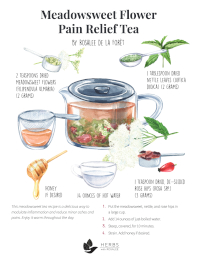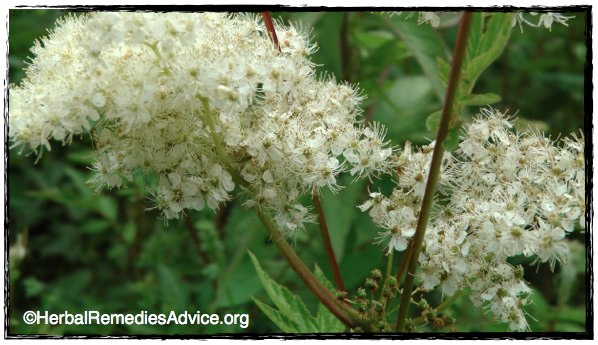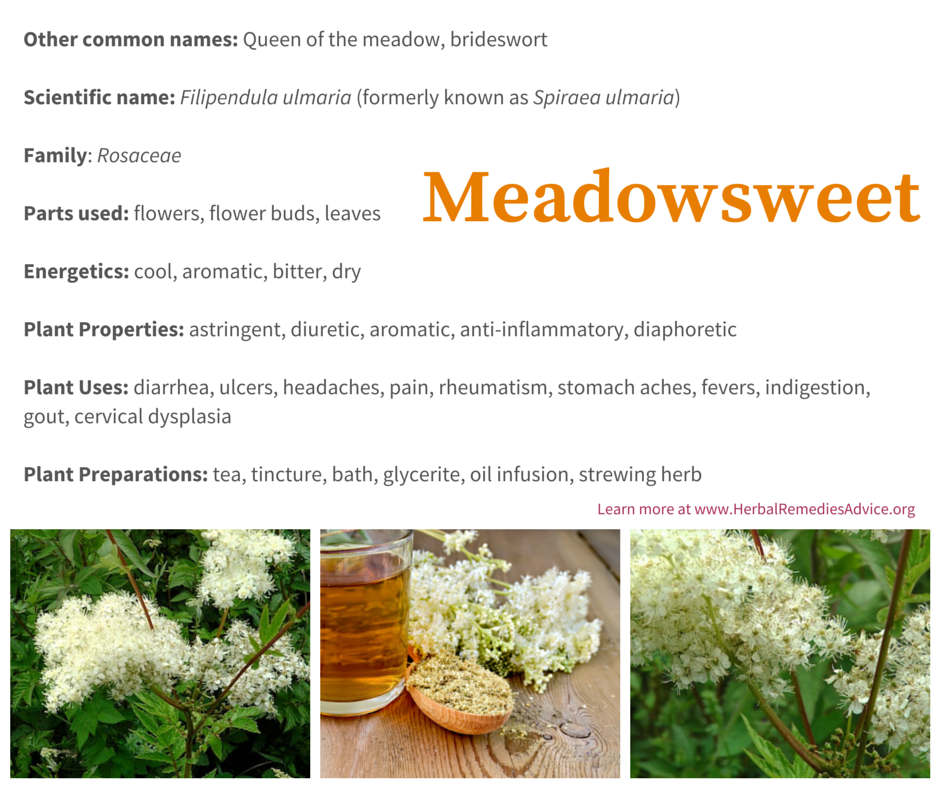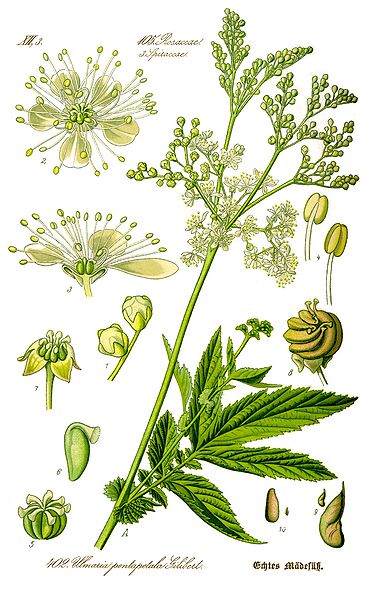Get weekly tips, recipes, and my Herbal Jumpstart e-course! Sign up for free today.
Meadowsweet Herb: Queen of the Meadow
Share this! |
|
There are so many medicinal benefits of meadowsweet herb! Some people think of meadowsweet simply as a natural form of aspirin. While it does shine at relieving pain (especially a particular type of pain!), meadowsweet’s gifts go far beyond this.
In this episode, I’ll be sharing my love of this beautiful member of the rose family, as well as one of my favorite ways to enjoy its pain-relieving benefits with my recipe for Meadowsweet Flower Pain Relief Tea. You’ll find a link to your free, beautifully illustrated recipe card in the section below.
By the end of this episode, you’ll know:
► How the herbal energetics of meadowsweet can help clue you in to its medicinal benefits
► Why using meadowsweet in its whole-herb form is safer than using aspirin
► The particular type of pain that meadowsweet excels at relieving
► Three different digestive issues that meadowsweet can help with
► and so much more….
-- TIMESTAMPS --
- 00:05 - Introduction to meadowsweet (Filipendula ulmaria)
- 01:57 - Meadowsweet energetics
- 03:16 - Meadowsweet and aspirin
- 05:07 - Benefits of meadowsweet for pain and inflammation
- 06:41 - Meadowsweet protects the digestive tract
- 09:57 - Using meadowsweet to address fevers and support the immune system
- 10:32 - Meadowsweet as a cancer preventive
- 11:15 - How to identify meadowsweet
- 12:15 - Special considerations
- 12:36 - How to make meadowsweet tea
- 16:26 - Herbal tidbit
Download Your Recipe Card!
l

Transcript of the Meadowsweet Herb Video
Meadowsweet’s botanical name is Filipendula ulmaria and it has many common names like queen of the meadow, pride of the meadow, meadow-wort, meadow queen, lady of the meadow… you probably see a theme here. With its splash of brilliantly white flowers, it brightens the meadows it loves to grow in. Meadowsweet is native to Europe and Asia and has become naturalized in many parts of North America.
Meadowsweet Herb Energetics
Meadowsweet is a member of the rose family, and it has many of the common characteristics within this family including being both cooling and astringent. Its aromatic qualities help to move stagnation and it’s commonly used when there are signs of heat like a sharp stabbing pain. As a drying herb it tightens and tones tissues through its astringent properties, but it’s also systemically drying through moisture loss via its diaphoretic and diuretic qualities.
If you’re new to the concepts of herbal energetics and understanding if a plant or a condition is hot or cold or damp or dry then you’re going to love the free mini herbal energetics course that I am hosting later this month.
This video training course will show you why herbal energetics is so important - especially when working with herbs for your health!
I’ll also be sharing an important safety guide for herbs as well as my Herbal Energetics Flavor Wheel.
Don’t miss out on this awesome training - it’ll only be available for a short time! Visit this page to sign up for the waitlist so you can be first in the door and not miss a thing. And, if you happen to be watching or listening to this episode after the free mini course is over, no worries, you can also sign up for the next time it’s offered.
Okay, let’s chat about meadowsweet and aspirin…
The Meadowsweet Herb and Aspirin
Meadowsweet has been used to reduce pain for hundreds and likely thousands of years.
In 1827, researchers identified and isolated salicylic acid from meadowsweet leaves. In the typically reductionist manner of western science, it was determined that this single constituent was responsible for meadowsweet’s pain relieving abilities.
But there was one problem! Taken by itself, salicylic acid created many problems, including stomach bleeding.
It wasn’t until 1897 that Felix Hoffman figured out how to chemically alter salicin taken from the meadowsweet plant to render it less troublesome for the stomach. Hoffman’s new chemical was named aspirin and was officially patented and sold by Bayer in 1900. Aspirin became a widely used medicine fairly quickly and this was the beginning of the class of drugs known today as NSAIDs.
Aspirin is still one of the most widely used drugs on the market with 40,000 tonnes of it being consumed each year around the world! Most people tend to think of over-the-counter medicines as being safe.
However, According to the American Gastroenterological Association (AGA - much easier to say), every year the side effects of NSAIDs hospitalize over 100,000 people and kill 16,500 people in the U.S. alone. The most common side effects of aspirin include bleeding ulcers and tinnitus.1
Ironically, or perhaps, notably, meadowsweet is commonly used by herbalists to heal the problems that aspirin creates. By isolating certain constituents within meadowsweet, and turning it into aspirin, we’ve left out natural buffering agents found in the whole plant.
So rather than think of the benefits of meadowsweet herb as a simple natural form of aspirin, there’s a lot more to this plant!
Here’s what I mean…
The Meadowsweet Herb Modulates Inflammation and Reduces Pain
As mentioned, meadowsweet is high in salicylic acid, which is well known for its ability to relieve pain. However, meadowsweet’s ability to relieve pain isn’t because of a single constituent.
Undoubtedly its ability to modulate inflammation is also due to flavonoids and tannins (not to mention aromatics).
Meadowsweet seems especially suited to stagnant pain (that’s pain located in a fixed location, possibly with a pounding sensation). It’s also helpful when there are symptoms of heat such as redness, acute swelling, and tissues that feel warm when you touch them.
Take headaches for example.
Meadowsweet is especially suited to headaches in which the person has a hot head and feels a pounding sensation in their head. Meadowsweet is cooling and it promotes circulation, which can relieve the stagnant energy causing the headache.
Meadowsweet can also address systemic pain and inflammation
Besides having the ability to relieve pain, meadowsweet also modulates inflammation. Taken daily as a tea or tincture it can help relieve chronic arthritic pain and inflammation.
Researchers have shown that the polyphenols within meadowsweet can strongly modulate inflammation in vitro,2 but there are probably many constituents within meadowsweet that contribute to its anti-inflammatory abilities.
The Meadowsweet Herb Protects the Digestive Tract
Earlier I mentioned that the earliest attempts at isolating constituents for medicine within meadowsweet failed because salicylic acid by itself is too harsh on the digestive tract.
Ironically, one of the best benefits of meadowsweet herb is that it shines for addressing a wide range of digestive problems.
As herbalist David Hoffman says, “Meadowsweet is one of the best digestive remedies available and as such will be indicated in most conditions, if they are approached holistically. It acts to protect and soothe the mucous membranes of the digestive tract, reducing excess acidity and easing nausea.”
Here’s some specific examples:
The Meadowsweet herb can Heal Ulcers
Meadowsweet has long been used to support and protect the digestive tract. And it’s not just for minor tummy aches! Meadowsweet is often considered specific for healing ulcers! (Which is especially interesting because aspirin can give people ulcers.) So meadowsweet for the win on that one!
Meadowsweet is high in tannins and flavonoids. The tannins, which are astringent, help to tighten and tone the mucous membranes of the digestive tract including the lining of the stomach.
By helping to pull tissues together, meadowsweet can both prevent and address ulcers. It also helps to relieve pain (often the worst symptom of ulcers) and it has anti-microbial activity that can help to address secondary infections.3,4
Another benefit may be due to meadowsweet’s ability to modulate the formation of histamine.5 While histamine is famous for its role in seasonal allergies, it can also play a role in stomach ulcerations.
All in all, meadowsweet is a wonderful herb for healing stomach ulcers. It is often used as part of a larger healing regimen rather than as a simple.
Herbalist Thomas Avery Garran recommends combining meadowsweet “with plantain leaf, marshmallow root and chamomile for chronic inflammation of the gastrointestinal tract.” David Winston likes to also combine it with licorice.
The Meadowsweet Herb can address Diarrhea
Many rose family plants are commonly used for diarrhea and meadowsweet is no exception. This astringent plant also tastes pleasant, making it a good choice for children. It can soothe upset tummies, relieve pain and help to stop excessive diarrhea.
The meadowsweet herb even helps for random stomach aches and acid reflux
It really shines as an herb for stomach aches, nausea and poor digestion and is especially helpful for those who find herbs like ginger to be too warming. Meadowsweet removes stagnation (like when you eat a meal and it stays in your stomach too long) and relieves general discomfort in the stomach.
My friend and fellow herbalist, jim mcdonald has this advice, “If someone asks you what to do for reflux but isn't going to come in and do a consult or listen to a lengthy exposition on the nuance of gastric tissues and processes I say, "You could try meadowsweet and see if that helps".
So next time you have some digestive woes, give meadowsweet a try. I especially love the flowers as a tea.

The Meadowsweet Herb To Address Fevers and Support the Immune System
Meadowsweet, when taken as a hot tea, is a relaxing diaphoretic herb. It promotes circulation and opens the pores to let the heat out of the body. It’s especially indicated when someone has a higher fever or feels hot but isn’t sweating.
A study to determine the benefits of meadowsweet as a functional beverage found that it is high in polysaccharides known to modulate the immune system.6 This gives us another reason to rely on meadowsweet during times of an upper respiratory infection.
The Meadowsweet Herb as a Cancer Preventive
Meadowsweet is famous for relieving pain, healing ulcers and addressing diarrhea, and it has also shown to have potential anticancer benefits as well.7
Meadowsweet has been shown to benefit people with cervical dysplasia (the presence of abnormal cell growth on the cervix). In this study 25 out of 48 women with cervical dysplasia had a complete remission after using meadowsweet ointment. (Cervical dysplasia is strongly associated with the HPV virus and has the potential to develop into cancer.)
It would be interesting to see more similar clinical trials.
How to Identify the Meadowsweet Herb
Meadowsweet loves to grow in damp meadows and banks. It is native to Europe and Asia, and has been naturalized in North America. It’s an easy plant to grow in your garden, it prefers damp soil, and it attracts many beneficial pollinators and insects. I always look forward to it blooming in my garden.
Meadowsweet grows from 3 to 5 feet tall.
It blooms from June to September and boasts creamy white flowers. The flowers are strongly aromatic and sweet smelling.
The individual flowers are quite small and have five petals and many
stamens, typical of the rose family. All those small flowers form this
gorgeous flower head. You can harvest these flower heads when they are
blooming and looking vibrant.
The leaves are dark green on top with a whitish and downy color on the underside. They grow as leaflets that are three to five lobed on the terminal leaflet. And then opposite as you go down the stem.
Special Considerations for Working with the Meadowsweet Herb
Meadowsweet is safe for most people. However, it should be used with caution in the following circumstances
- children under 16 who have the flu or chickenpox symptoms (because of the rare but serious Reye’s syndrome)
- people who are sensitive or allergic to aspirin
How to make a Meadowsweet Tea Recipe
Meadowsweet is a versatile plant that can be worked with in a variety of ways.
A simple tea from meadowsweet is wonderful medicine. It is strongly aromatic, sweet and slightly astringent. To make your own cup of tea, use a heaping tablespoon of the dried flowers, or about 4-6 grams, per pint of just boiled water. Steep covered from 5 - 15 minutes. It will get noticeably more bitter with the longer steeping time.
Meadowsweet can also be combined with other herbs for added benefits. Here’s my recipe for:
Meadowsweet Flower Pain Relief Tea
This meadowsweet tea recipe is a delicious way to modulate inflammation and reduce minor aches and pains. Enjoy it warm throughout the day.
The ingredients are:
- 2 teaspoons dried meadowsweet flowers (Filipendula ulmaria) (2 grams)
- 1 tablespoon dried nettle leaves (Urtica dioica) (2 grams)
- 1 teaspoon dried, de-seeded rose hips (Rosa spp.) (3 grams)
To make this steep the herbs in 14 ounces of hot water, covered, for 10 minutes.
Strain. Add honey if desired.
Enjoy!
Download your free printable recipe card for this meadowsweet tea recipe above this transcript!
If you enjoyed this video on the benefits of meadowsweet herb and you value trusted herbal information, then I hope you’ll stick around! The best way to get started is to subscribe on YouTube and your favorite podcast app.
After you’ve subscribed, don’t forget to sign up for the free mini herbal energetics course that is releasing later this month!
In this online training you’ll learn how to get the skills to be an herbalist,” so you can confidently choose the herbs that actually work for you and your family (without memorizing lists of herbs or being fearful of making things worse)! In fact be giving you a safety framework so you can feel more confident when working with herbs. We’ll also have tea tastings, and you’ll get a copy of the Herbal Energetics Flavor Wheel - it’s going to be a lot of fun! Get on the waitlist so you don’t miss it!
Okay, you’ve lasted to the very end of the show which means you get a gold star and this herbal tidbit…
Meadowsweet is not only medicine for humans but can also help us clean up our messes.
Meadowsweet has been shown to remove heavy metals like cadmium and lead from storm water.8 While this may be a beneficial quality for helping humans to clean up their industrial waste, it’s also important to harvest meadowsweet from areas free of metal contamination.
Citations for Meadowsweet Herb
Click to show/hide.

Rosalee is an herbalist and author of the bestselling book Alchemy of Herbs: Transform Everyday Ingredients Into Foods & Remedies That Healand co-author of the bestselling book Wild Remedies: How to Forage Healing Foods and Craft Your Own Herbal Medicine. She's a registered herbalist with the American Herbalist Guild and has taught thousands of students through her online courses. Read about how Rosalee went from having a terminal illness to being a bestselling author in her full story here.



